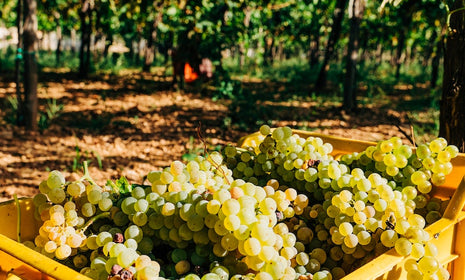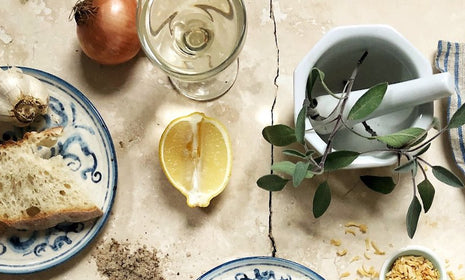Sprung from the depths of the Mediterranean, Sicily’s long, warm, dry summers paired with moderate winters and volcanic soils make it a grower's paradise. Sicily has therefore become synonymous with lemons, olives, almonds, and of course, grapes. Its sloping volcanic hills, abundant sunlight, and arid climate have cultivated beautifully saline wines for over 6,000 years. While there’s evidence of earlier wine production, ancient Phoenecian explorers modernized the process, bringing their knowledge of grape farming, harvesting, and fermenting to the island of Sicily, in 1100 BC. By the time of the Roman Empire, Sicily had become heralded for the unique wines of its vintners. Boasting an array of indigenous varietals, Sicily is today known not only for its unique grapes but also for the distinct characteristics lent to its wines through its terroir. And with 450 wineries in Sicily, there’s plenty of variety to discover.
The world of wine can be complicated, overwhelming, and cumbersome. Like all things Sicilian, we believe its wine is simple, elegant, and delicious. We hope you enjoy the brief guide to our favorite Sicilian wines to drink along with some of delicious pairing suggestions. Who knows, it might just inspire you to plan a trip and taste for yourself!

Nero d’Avola
The most celebrated and widely planted grape found in Sicily, Nero d’Avola was brought to the island by Greeks in 6th Century BC. Its wines are characterized by a full depth of flavor, fruit-forward acidity, and well-balanced minerality. Primarily found in the southern Cerasuolo di Vittoria appellation, Nero d’Avola wines are complex yet very drinkable, and are best when enjoyed with food.
Pair with: braised lamb, grilled pork chops seasoned with Bona Furtuna Erbe di Sicilia, and smoked eggplant.
Nerello Mascalese
Grown primarily on the volcanic slopes of Mount Etna, this high-altitude red varietal produces wonderfully elegant wines that are fruit-forward and mineral, yet beautifully light, crisp, and slightly herbaceous. Dating back to the 1800s, this young grape varietal is among the few to have survived the phylloxera plague that destroyed a large number of Siciliy’s vineyards in the 1880s as a result of its high-altitude habitat. When blended with other Sicilian-grown grapes, Nerello Mascalese brings fresh clarity to the wine, as experienced in stunning Etna Rosso.
Pair with: penne pasta with Bona Furtuna Pesto Trapanese or grilled swordfish with sundried tomatoes.
Frappato
While some wine historians trace Frappato’s origin story back to Grecian-Sicily in the 6th Century BC, others believe the varietal is of Spanish origins, making its way to Vittoria through the Countess Vittoria Colonna Henriquez-Cabrera in the late 18th Century. Regardless, this beautifully fruit-forward, light, and bright grape enchants all who meet it. Often blended with Nero d’Avola to create a stunningly elegant blend, on its own, frappato is easy to drink while maintaining its fruity and distinctly floral palate.
Pair with: Spaghetti alla vongole or tuna carpacio with capers and fresh lemon.
Carricante
From the black, spongy soils of Mount Etna springs this stunning white wine. Like many of its sister grapes, carricante can be traced back to 6th Century Grecian-Sicily. Structured and bursting with complexity, this grape has since produced a balanced white wine that is citrus forward, herbaceous, dry and yet beautifully round. With balanced salinity from the Mediterranean breeze, and subtle minerality rippling through its well-structured body, this is a hidden treasure among white wine.
Pair with: a soft goat cheese like caprino or risotto with dried porcini mushrooms.

Zibibbo
Otherwise known as Muscat of Alexandria, the zibibbo grape has been grown, dried, fermented, and eaten since Pharaohs ruled the Nile. Much like its versatility in consumption (dried, fresh or fermented), the zibibbo grape can be used to produce a variety of wines: from dry whites to more full-bodied skin-contact and deliciously sumptuous dessert wines. It is in this last iteration, as Moscato di Pantelleria, that zibibbo really sings of apricot and floral notes.
Pair with: a variety of cheeses or Pasticcini Siciliana alle Mandorle.
Grillo
Unilke most of Sicily’s grape varietals, Grillo grapes are not ancient, but rather a crossbreed of Catarratto and Zibibbo grapes. While the grape has gained recent notoriety as a pinnacle example of strikingly different expressions of wine through natural vintner practices, it has for years been used to make the world-renowned fortified sweet wine Marsala. With a wide range of uses, for cooking, as an aperitivo or digestivo, Marsala wine is made from any combination of grapes native to Sicily such as Grillo, Inzolia, and Catarratto. As a result, these wines have a large spectrum of flavor and texture, from dry and aromatic, to sweet and almost syrupy. A high-quality Marsala wine will have nuanced flavor profiles, balancing notes of cherry, tobacco, nuts, and honey.
Pair with: figs with blue cheese, walnuts and honey, or glazed cherry pastries.
Malvasia
Another grape tied historically to the Greeks, Malvasia has been used to produce a large array of wines, from dry to sparkling, and most famously sweet. Grown and produced on the volcanic archipelago, the Aeolian Islands just off the coast of Sicily, the fortified sweet wine produced by these mineral-rich grapes is full of apricot and stone fruit sweetness with a delicate and herbaceous floral palate.
Pair with: honeyed pears, soft goat cheese, and Chocolate and Malvasia Panettone.






Be the first to comment